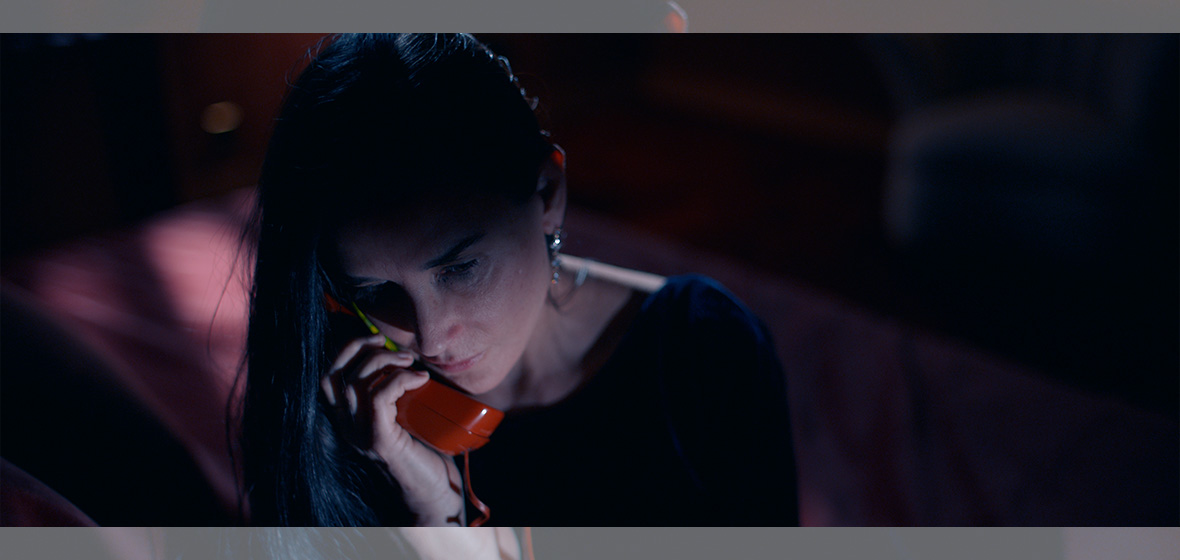Coralie Fargeat’s The Substance comes at its audience with the strength of ten thousand punches and never stops to rest during its almost two-hour and twenty-minute runtime. For a film that has been making a triumphant round of film festivals, including Cannes, where it was awarded best screenplay, it’s graced with a surprising, maybe even refreshing, lack of subtlety. Its thesis is exposed in the first shot – an overhead view of a star on the Hollywood Walk of Fame, first revered by fans and curious passersby, but as time passes, forgotten as just another piece of pavement.
The Substance is a film about the fickleness of image and fame. How Hollywood chews up and spits out the stars that make for the perverse titillation (both sexual and financial) of an old white, wealthy man. It’s a film about society’s obsession with image, controlled, honed and exploited by the need for capital and entertainment. It’s a film about how we’re all witnesses and victims of this perversity. And that’s it. That’s what The Substance is about. The idea is explored without much interest in depth. The irony is that The Substance has little of it.But we can’t say it doesn’t deliver on its promises.
The name of that star on the Walk of Fame, now cracked by time, is Elisabeth Sparkle (Demi Moore). Once a loved actress, she is now the star of a fitness show in the vein of Jane Fonda. Time is an enemy Sparkle doesn’t see coming, basked by the glory of her career that adorns the long corridor outside the studio where she records her show. That is until she overhears an executive named Harvey (Dennis Quaid), because what else would his name be, loudly call for her replacement to someone younger and more attractive.
The grief that consumes Sparkle is not the fact she’s losing her job but that she’s losing her shine. The world doesn’t want to see her on television anymore because the world doesn’t find her physically appealing. Even if she’s still Demi Moore, walking in Demi Moore’s body. Sparkle discovers she can’t operate her way out of this inevitability. She’s introduced to a secretive product simply called ‘the substance’. Under a strict set of rules, the product creates a younger, better version of oneself with a bunch of caveats – the dose can only be used once, every seven days, the older version (called ‘the matrix’) takes over, and every morning the young version (called ‘the other’) needs to inject a stabiliser made from the matrix’s spinal fluid.
Enter Sue (Margaret Qualley), Sparkle’s better version. She is young, beautiful, and exciting. She auditions for the new fitness show and takes the whole world like an avalanche. Everyone loves her. The camera follows her curves with depraved intensity like the fitness part is just an excuse for it (and, in turn, us) to gawk at her body. Every seven days, she reluctantly trades with Elisabeth, who now lives a recluse life at home, growing jealous of Sue’s perfect life.
Of course, because this is a horror film, every rule set for the substance is broken, leading to harsh, vile consequences. It’s The Picture of Dorian Gray, directed by David Cronenberg.
Fargeat stylises the film by turning the male gaze upside down and inside out. Her camera is invasive and uncomfortable. Men are repulsive, shot with a distorted wide-angle lens that heightens their grotesque features. The volume of bodily fluids increased to 11 to make the audience even more uncomfortable. In a scene at the start, Quaid’s Harvey eats prawns in a restaurant in the most unappealing fashion. Like Jabba the Hutt shot in those Ellen Burstyn dream sequences from Requiem for a Dream. Each slurp on the prawn’s head is just as sickening as watching someone’s guts fallingout.
The problem is that’s the only speed The Substance has. I praise how Fargeat commits to the message, but she leaves little depth to explore the faults of this culture. Moore plays Sparkle with despairing strength. You feel her struggle, her envy sweating through her skin as she looks at a gigantic Sue billboard outside her window. Because the two, Elisabeth and Sue, are ultimately the same person, they share memories but react differently: Elisabeth, like a depressed senior who gave up on life, and Sue, like a spoiled teenager, used to havingthe whole world handed to her.
The problem is that the dynamic doesn’t evolve beyond snowballing into chaos. Fargeat isn’t interested in complementing her thoughts about toxic beauty culture, and how permeated it is in patriarchal control. Elisabeth is a victim, a sacrifice at the altar of senseless capitalism (what other kind is there?), but Fargeat doesn’t give her a chance to realise that. Because of that, The Substance is sometimes too cruel to be taken seriously. The satire is exhausted halfway through and only finds a new breath in the last twenty minutes – when any semblance of sense is thrown out the window, and Fargeat gives in to her most extreme impulses.
Those last twenty minutes are a sight to see – the strongest the film has to offer. It reminded me of the work of Brian Yuzna, a cult horror director from the 80s who had the good sense to end his films with some of the most grotesque and nightmarish visions he could think of. I wouldn’t dare to describe what happened, and I suspect that if I did, you wouldn’t believe it. It’s ironic because that part of the film works best because it drops any pretence of anything beyond vomit-inducing shock value. And that’s great. The tragedy of Elisabeth Sparkle works best when it’s not trying to be patronising to its subjects. When it forces a literal audience to face the monster they alone created. But it takes so long to get there, and I’m afraid the message gets muddled along the way.
Verdict: 3.5 out of 5
For everyone waiting for the Demi-ssance, Moore returns with so much style and grace it reminded us why she was, at a point, the biggest star in the world. And for fans of body horror pictures who were never taken seriously by their cinephile friends. This is not on the level of Julia Ducournau, but it’s getting there.




